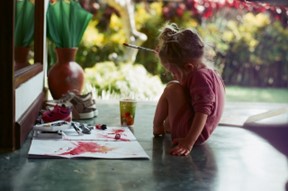Why Creativity is Important in Childhood Development

A childhood without the arts is often a childhood without creativity.
And that’s not much of a childhood at all.
Since naturally curious children especially thrive when creative outlets are regularly explored, introducing the joys of art (and the arts in general) early and often is essential to unstructured and organic development.
Even for young children, creativity is pure self-expression and vital self-exploration. The arts often quickly become a vital window into a child’s self-identity as well.
And art — free time to paint, classes on drawing, sculpture, and photography — is one of the best ways to support a child’s burgeoning emotional health.
Frederica Wald discusses a few of the ways that creativity and the arts are essential elements of positive childhood development.
Increased Self-Confidence
It’s never too early for a child to learn the value of self-confidence. Research has shown that children develop a sense of self-esteem as strong as one held by adults by the tender age of 5.
The arts are a big part of developing confidence, whether it’s through free expression and experimentation or being encouraged through positive feedback on a painting.
When creativity is clearly shown to be valued and appreciated, that’s something children always remember.
Cognitive and Motor Skills Development
Art offers easy access to the complexities of the world. Children who paint or draw learn about the world of shapes and colors at the same time.
Artistic tools such as glue and markers and paintbrushes are introduced and used in artistic experimentation and creative problem-solving.
Children make unique choices and solo decisions when exploring the arts. The bottom line: creativity and cognitive development seamlessly go hand-in-hand.
At the same time, motor skills are developed when creating art. Children learn how to hold a crayon to color and grasp a paintbrush to create unique strokes. Dexterity is learned through using scissors and that same dexterity is used for even more advanced artistic experimentation.

Cultural Exploration
While children become more aware of themselves through the arts, the arts also are the perfect forum for cultural awareness and exploration. Through exposure to the arts, children begin to see the world through different lenses of societal views and cultural celebration.
Seeing differences in color and dance, in imagery and artistic forms helps children not just understand that there’s diversity in the world but embrace it.
Improved Language Skills
Art is described in an evocative language all its own. And when children are artists, they learn this language, whether it’s through describing their work or by sharing their artistic process.
Children will ask each other questions about what went into the work as well, and adults and teachers can even encourage further language development by asking open-ended questions about the creativity that’s so clearly on display.
The arts let children use and learn words that are new to them, such as texture and style, and brushstrokes. Children learn descriptive words such as vibrant and muted and expressive.
When children create art, they also access a world of language that can only be used to describe the art of the wider world.